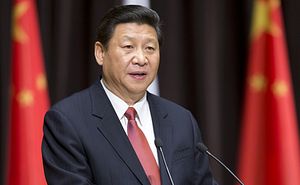Will a rising China challenge the United States and its allies over global and regional governance? The issue of whether China is bound to become a revisionist power or will choose to support the U.S.-led international order has guided debates on China’s foreign policy for more than two decades.
While the number of adherents to these two positions has shifted considerably, the level of Chinese revisionism in East Asia has arguably been quite constant. China has not outright challenged U.S. power, but has also not stayed away from occasional confrontations with the U.S. and its allies. Even the supposed new trend of “assertiveness” since 2009 does not seem to depart from China’s previous behavior.
In the early 1990s, many predicted that a rapidly developing China was destined to pursue a revisionist course. The end of the Cold War increased the demand for forecasts of what the new world order would look like. East Asia, many concluded, was “ripe for rivalry” and China was set to confront U.S. hegemony. China’s leaders also seemed to fulfill these fears as they eagerly called for the transition to a multipolar world order.
However, in the face of international resistance and overwhelming U.S. power, the Chinese leadership scrapped this line and instead opted for a reassurance policy toward the end of the 1990s. By the mid-2000s, the consensus among experts held that China was a beneficiary and supporter of the status quo, at least for the moment. China’s economic and military rise had not delivered the expected revisionism.
In 2009, however, claims of Chinese revisionism returned with a vengeance. Numerous China watchers explained a series of confrontations involving China with the claim that Chinese foreign policy suddenly had shifted toward a hard line posture.
This time, China was labelled “assertive,” but it was clearly an updated version of the old revisionism argument. China’s leaders, according to proponents of the argument, were making a renewed attempt to contest the U.S.-led order.
Despite the hype surrounding the assertiveness narrative, closer scrutiny calls into question its accuracy. The problem has partly been a tendency to exaggerate and cherry-pick evidence of Chinese assertiveness. However, even if we control for these instances, there is no denying that recent years have featured many cases of Chinese assertiveness.
The main problem with the narrative, however, is that if China is “more” assertive today, it must have been “less” assertive before. So when was this alleged unassertive period? Chinese assertiveness in the 1990s—including the Taiwan Strait crisis in 1995-1996—is well known. This means that the unassertive period against which proponents of the narrative are comparing China’s recent assertiveness must have been in the first decade of the 2000s, when Chinese leaders touted its “peaceful rise.” However, this period too had its fair share of assertiveness.
In 2001, for instance, China detained and interrogated 24 crew members of an American EP-3 surveillance plane after a collision with a Chinese fighter jet. In 2002 China temporarily closed its border with Mongolia to protest the Dalai Lama visiting Ulan Bator.
In 2004, a Han-class submarine surfaced in undisputed Japanese territorial waters on its way home from circumnavigating Guam. In 2005, Chinese civilian law enforcement vessels killed nine Vietnamese fishermen in the South China Sea. The same year, the Communist Party allowed large-scale anti-Japanese demonstrations and a PLAN missile frigate aimed a gun at a Japanese Maritime Self-Defense Force Surveillance plane in a disputed area in the East China Sea. In 2006, an undetected Song-class submarine surfaced within torpedo range of the U.S. aircraft carrier Kitty Hawk during a military exercise in the East China Sea.
In 2007, China provocatively blew up an old weather satellite with a kinetic projectile. The same year, a Chinese navy vessel sank a Vietnamese fishing vessel in the South China Sea, killing one fisherman. In 2008, China heavily lambasted European leaders for their criticism of China’s handling of human rights in Tibet.
Many more examples exist. In other words, there was clearly no lack of Chinese assertiveness during the years 2001-2008—the allegedly relatively unassertive period against which China’s post-2009 behavior is contrasted. The conclusion is thus that China’s assertiveness seems to have been relatively constant even since its leaders adopted the reassurance strategy in the late 1990s. China’s assertiveness is not new; it has been there all along. China, while largely accepting the U.S.-led order, has never stopped confronting or declining to go along with the U.S. and its allies over a number of issues.
Of course, although China’s assertiveness is not new, this fact does not rule out a major Chinese foreign policy shift being around the corner. The leadership under Xi Jinping might possibly decide that it is time for China to quit lying low and start throwing its weight around.
But before one proclaims that recent assertiveness is evidence of such a transition, it is worth checking the historical record: did China behave less assertively in similar situations 5, 10 or 15 years ago? Since reports of unprecedented Chinese assertiveness are likely to continue appearing, this point is useful to bear in mind.
Björn Jerdén is a Ph.D. candidate at Stockholm University and a Research Associate at the Swedish Institute of International Affairs. His new article “The Assertive China Narrative: Why It Is Wrong and How So Many Still Bought into it” appeared in the Chinese Journal of International Politics.

































